Gone are the days when we used to play games all day and didn’t even know what precisely the role of the GPU was. Over time, the quality of the display and graphical complexity in games have improved. Texture quality, Antialiasing, VSync, Motion Blur, Field of View, and such graphical features require more GPU power and capability.
3–4 GB of RAM GPUs are no longer capable of running the majority of games available on Steam. Even the 8GB RAM GPUs are not capable of running many popular games smoothly and may require some high-end GPUs. It is not just the VRAM that is the reason to make the GPU capable. Its Cuda codes, memory interface, and clock speed also contribute to its capability.
As such, while buying a GPU, you have to consider these factors as well. To make your decision reliable and future-proof, we’ve added that information beneath the GPUs as well.
However, 8GB of VRAM is an affordable choice for many and ensures the smooth running of considerable games. It is also a suitable segment for content creators who edit videos, design graphics or do 3D modeling work.
Software such as Premiere Pro, Blender, Photoshop, and DaVinci run very smoothly on 8GB VRAM GPUs. Well, in this article, we’ve listed the best 8GB VRAM GPUs of 2024, including insights into performance, user reviews, and future-proofing.
What is VRAM GPU?
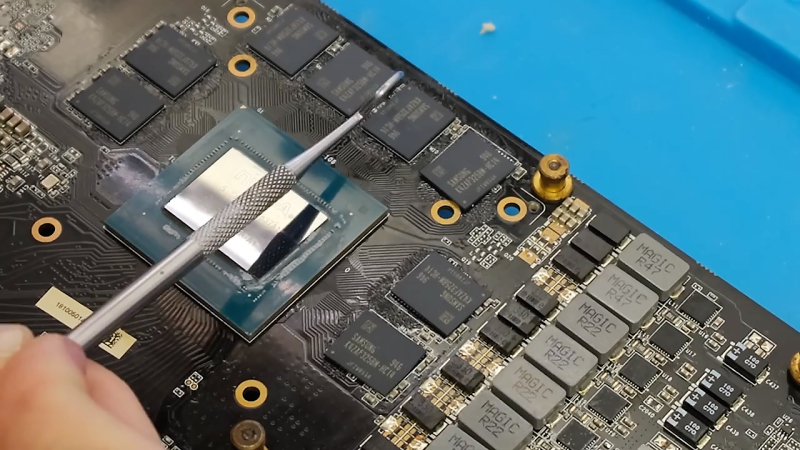
Video memory, commonly known as VRAM, is a specialized form of memory situated within Graphics Processing Units (GPUs) in computer systems.
Diverging from the all-encompassing nature of system RAM, which caters to general computing needs, VRAM is exclusively designed for graphics-related functions.
Its principal role involves the storage and rapid retrieval of visual data, encompassing textures, frame buffers, and other graphical elements essential for image rendering on display.
Within the GPU domain, VRAM assumes a pivotal role in augmenting graphics performance, facilitating smoother and more effective processing of intricate visual information.
The measurement unit for VRAM capacity is gigabytes (GB), directly impacting a graphics card’s prowess in handling high-resolution textures and supporting advanced graphics features. This influence contributes significantly to delivering an optimal gaming or graphical computing experience.
Importance of VRAM in Gaming
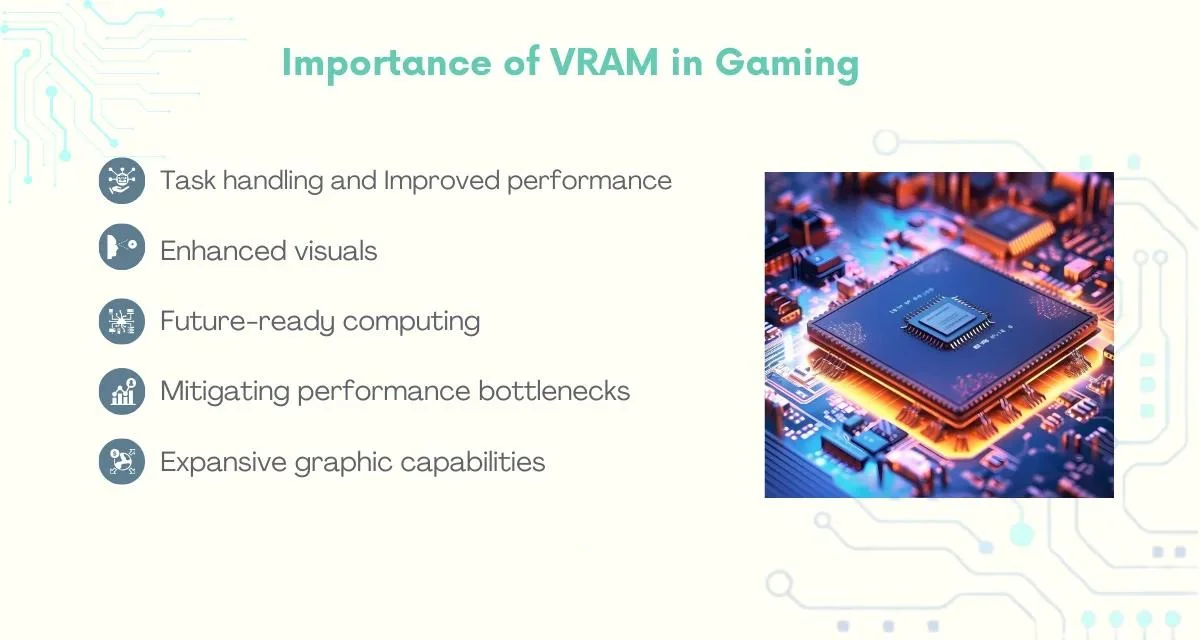
VRAM functions as a high-speed memory buffer dedicated to swiftly storing and accessing the data essential for graphics rendering. It houses textures, shaders, and various graphics assets utilized by the GPU to process and exhibit images on the screen.
Adequate VRAM proves indispensable for rendering intricate scenes, high-resolution textures, and advanced graphical effects without compromising performance or introducing visual anomalies into your gaming escapades.
Steam Survey reveals a notable surge in gaming displays featuring a 2560x1440p resolution, emerging as the swiftly growing choice among gamers.
With a substantial 75% more pixels than the prevalent 1080p resolution, 1440p stands as the contemporary sweet spot for both esports and AAA gaming, offering sharper images and heightened detail to breathe life into your gaming environment. However, as pixel count increases, so does the demand on your PC’s graphics card.
The optimal VRAM size varies depending on the resolution you opt for (be it 1080p, 1440p, or 4K). Striking the right balance with VRAM empowers you to wield greater control over your gaming encounters, ensuring you extract maximum value from your investment in your PC rig.
Here’s why it matters:
Seamless task handling and improved performance:
VRAM serves as a temporary storage hub for crucial graphical elements such as textures, meshes, and lighting data. Sufficient VRAM ensures that these elements are readily accessible, enabling your GPU to process tasks more efficiently. This translates into smoother performance, higher frame rates, and an overall more responsive computing experience.
Enhanced visuals and expansive graphic capabilities:
As gaming evolves, so do the demands on VRAM. With modern games offering higher resolutions and advanced graphical features, a robust VRAM capacity becomes indispensable. Whether it’s 1440p, 4K, or cutting-edge graphical effects like ray tracing, having ample VRAM prevents issues like texture pop-in, stuttering, and crashes, particularly when pushing graphics settings to their limits.
Future-ready computing:
The landscape of digital entertainment is ever-changing, with new games pushing hardware boundaries. By ensuring your system boasts ample VRAM, you’re future-proofing your setup. What was considered optimal a few years ago might fall short for upcoming titles. Embracing larger VRAM capacities, such as 12GB or 16GB, is increasingly recommended for handling the demands of future gaming and high-resolution content.
Mitigating performance bottlenecks:
VRAM collaborates with other integral components, like the CPU and RAM. Bottlenecks arise when one component lags, hindering overall system performance. Having sufficient VRAM helps prevent it from becoming the weak link in the chain, ensuring a harmonious balance that optimizes your gaming and computing experience.
The Best 8GB vRAM GPU in 2024
ASUS Dual Radeon RX 6600 8 GB GDDR6
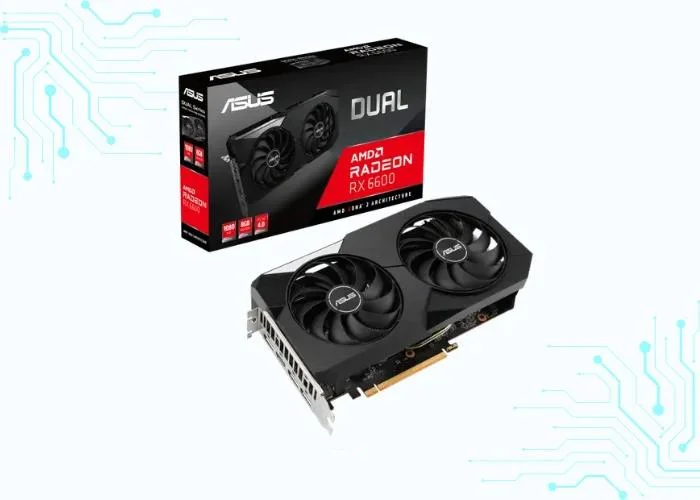
The ASUS Dual Radeon RX 6600 8 GB GDDR6 is a mid-range graphics card that was released in late 2020. It is based on AMD’s RDNA 2 architecture and is powered by the Navi 23 GPU. The card has 32 compute units, 8GB of GDDR6 memory, and a boost clock of up to 2491 MHz.
The ASUS Dual Radeon RX 6600 is a good option for gamers who are looking for a 1080p gaming experience at high frame rates. It can also handle some 1440p gaming, but you may need to turn down the graphics settings in some games.
The ASUS Dual Radeon RX 6600 is a relatively affordable graphics card, making it a good option for budget-minded gamers. However, it is not the most powerful card on the market, so if you are looking for the best possible performance, you may want to consider a higher-end model.
| Attribute | Specification |
|---|---|
| Chipset | AMD Radeon RX 6600 |
| Memory Interface | 128-bit GDDR6 |
| Clock Speed | Base: 1626 MHz, Boost: Up to 2491 MHz |
| VRAM | 8 GB GDDR6 |
| Brand and Model | ASUS Dual Radeon RX 6600 8 GB GDDR6 |
| Minimum Power | 450 Watts |
BROLEO RX 580 Graphics Card

The BROLEO RX 580 Graphics Card is a budget-friendly graphics card that can handle 1080p gaming at high settings and even some 1440p gaming at lower settings. It’s based on the AMD Radeon RX 580, which was released in 2017, but it’s still a decent option for gamers on a budget.
It has 8GB of GDDR5 memory and a boost clock of up to 1284MHz. It also supports PCI Express 3.0 and has two DisplayPort outputs, one HDMI output, and one DVI output.
In terms of performance, the BROLEO RX 580 can handle most 1080p games at high settings, and it can even handle some 1440p games at lower settings. For example, in benchmarks, the RX 580 can average around 60fps in Shadow of the Tomb Raider at 1080p on high settings and around 40fps at 1440p on medium settings.
| Attribute | Specification |
|---|---|
| Chipset | AMD RX 580 |
| Memory Interface | 256-bit GDDR5 |
| Clock Speed | Base: 1.25 GHz Boost: 1.34 GHz |
| VRAM | 16 GB GDDR5 |
| Brand and Model | BROLEO RX 580 |
| Minimum Power | 500 Watts |
Sapphire Pulse AMD Radeon RX 6650 XT

The Sapphire Pulse AMD Radeon RX 6650 XT is a mid-range graphics card that was released in January 2022. It is based on the AMD RDNA 2 architecture and features 2048 stream processors, 8GB of GDDR6 memory, and a boost clock of up to 2635 MHz.
The Sapphire Pulse RX 6650 XT is a good choice for 1080p and 1440p gaming at high frame rates. It can also handle some 4K gaming, but you may need to lower the graphics settings in some games. The card also supports ray tracing, but the performance is not as good as higher-end cards.
The Sapphire Pulse RX 6650 XT is a good value for the price. It is cheaper than many other RX 6650 XT cards, and it offers good performance for the money.
| Parameter | Specification |
|---|---|
| Chipset | AMD Radeon RX 6650 XT |
| Memory Interface | 128-bit GDDR6 |
| Clock Speed | Base: 2055 MHz, Boost: 2635 MHz |
| VRAM | 4GB GDDR6 |
| Brand and Model | Sapphire Pulse AMD Radeon RX 6650 XT |
| Minimum Power | 500 Watts |
ASUS Turbo GeForce RTX 3070 V2

The ASUS Turbo GeForce RTX 3070 V2 is a high-end graphics card that is based on the NVIDIA Ampere architecture. It features 5888 CUDA cores, 8GB of GDDR6 memory, and a boost clock of up to 1755 MHz.
The card is also equipped with second-generation RT cores and third-generation tensor cores, which provide improved performance for ray tracing and AI-powered features.
The ASUS Turbo GeForce RTX 3070 V2 is designed for gamers who want the best possible performance in demanding AAA titles. It is also a good choice for content creators who need a powerful GPU for video editing, 3D rendering, and other creative tasks.
However, it is also one of the most expensive graphics cards on the market. If you are on a budget, you may want to consider a more affordable option.
| Parameter | Specification |
|---|---|
| Chipset | NVIDIA GeForce RTX 3070 |
| Memory Interface | 256-bit |
| Clock Speed | Boost Clock: Up to 1725 MHz |
| VRAM | 8 GB GDDR6 |
| Brand and Model | ASUS Turbo RTX 3070 V2 |
| Minimum Power | 650 Watts (recommended) |
INNO3D Geforce RTX 3050 Twin X2
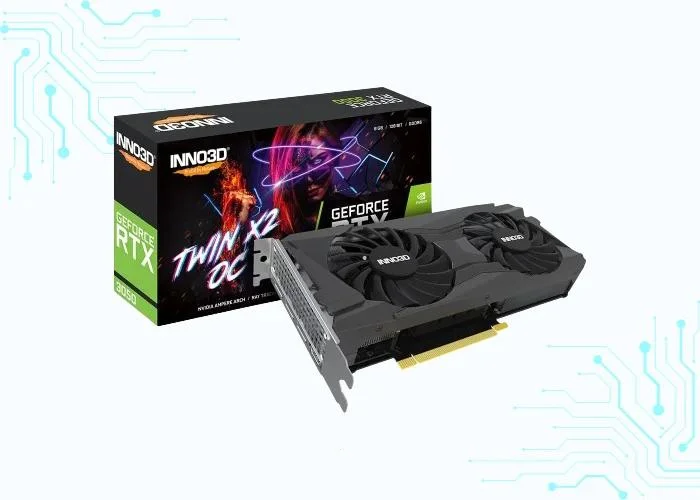
The INNO3D GeForce RTX 3050 Twin X2 is a mid-range graphics card that was released in 2021. It is based on the NVIDIA Ampere architecture and features 2560 CUDA cores, 8GB of GDDR6 memory, and a boost clock of up to 1822 MHz (for the OC version).
It is a good choice for 1080p gaming at high frame rates, and it can also handle 1440p gaming at moderate settings. It also supports real-time ray tracing and NVIDIA DLSS, which can improve image quality and performance in supported games.
The INNO3D RTX 3050 Twin X2 comes in two versions: a standard version and an OC version. The OC version has a higher boost clock and a slightly higher power draw, but it offers slightly better performance.
The RTX 3050 is a good value for the price, but it is not the best-performing RTX 3000 series card. If you are looking for the best possible performance, you should consider the RTX 3060 or RTX 3070. However, if you are on a budget, the RTX 3050 is a great option.
| Attribute | Specification |
|---|---|
| Chipset | NVIDIA GeForce RTX 3050 |
| Memory Interface | 128-bit GDDR6 |
| Clock Speed | Base speed: 1552 MHz, Boost speed: 1777 MHz |
| VRAM | 4GB GDDR6 |
| Brand and Model | INNO3D GeForce RTX 3050 Twin X2 |
| Minimum Power | 450 Watts |
GIGABYTE Nvidia GeForce RTX 3070 Vision OC
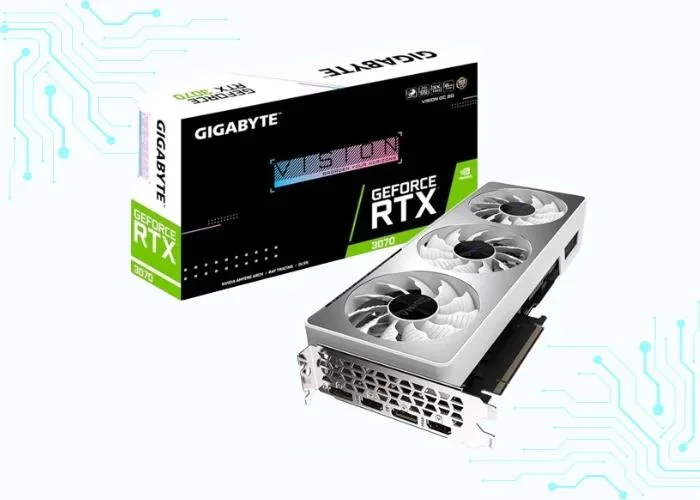
The GIGABYTE Nvidia GeForce RTX 3070 Vision OC is a high-end graphics card that was released in 2020. It is based on the NVIDIA Ampere architecture and features 8GB of GDDR6 memory. The Vision OC model is factory overclocked for improved performance.
It is a powerful graphics card that can handle even the most demanding games at high resolutions and frame rates. It also supports features like ray tracing and DLSS, which can further improve image quality and performance.
The GIGABYTE Nvidia GeForce RTX 3070 Vision OC is a great choice for gamers and creative professionals who need a powerful graphics card. However, it is important to note that it is a high-end card and therefore comes with a high price tag.
Specification:
| Attribute | Specification |
|---|---|
| Chipset | Nvidia GeForce RTX 3070 |
| Memory Interface | 256-bit GDDR6 |
| Clock Speed | Base: 1500 MHz, Boost: 1845 MHz |
| VRAM | 8 GB GDDR6 |
| Brand and Model | GIGABYTE Nvidia GeForce RTX 3070 Vision OC |
| Minimum Power | 650 Watts |
ASUS Dual GeForce RTX 3050 V2 OC
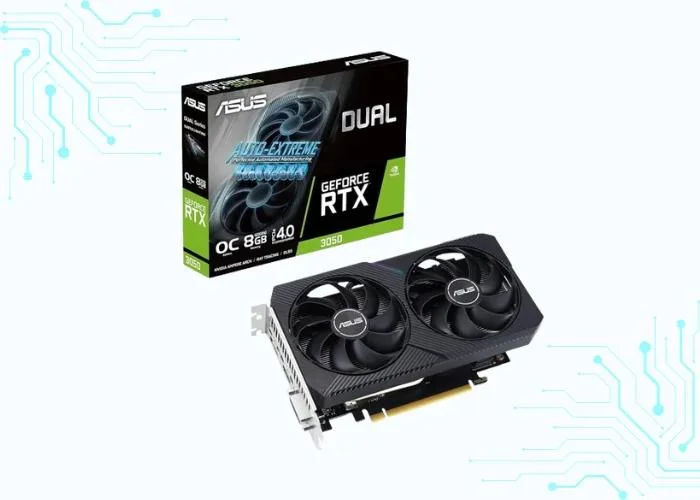
The ASUS Dual GeForce RTX 3050 V2 OC is a mid-range graphics card based on the NVIDIA Ampere architecture. It’s a good option for 1080p and 1440p gaming, and it can handle some ray tracing at lower resolutions. The card has 8GB of GDDR6 memory and a boost clock of up to 1852 MHz.
It can handle most 1080p and 1440p games at high settings. It can also handle some ray tracing at lower resolutions, but you’ll need to turn down the graphics settings for a smooth experience. In benchmarks, the RTX 3050 V2 OC outperforms the previous generation GTX 1650 Ti by a significant margin.
The ASUS Dual GeForce RTX 3050 V2 OC is a good option for gamers who are looking for a mid-range card that can handle 1080p and 1440p gaming. It’s also a good choice for those who want to try out ray tracing. The card is well-cooled and compatible with most cases.
Specification:
| Property | Specification |
|---|---|
| Chipset | NVIDIA GeForce RTX 3050 V2 |
| Memory Interface | 128-bit |
| Clock Speed | Boost Clock: Up to 1777 MHz |
| VRAM | 4GB GDDR6 |
| Brand and Model | ASUS Dual GeForce RTX 3050 V2 OC |
| Minimum Power | 300 Watts (Recommended PSU) |
XFX Speedster SWFT 210

At the heart of the XFX Speedster SWFT 210 lies the formidable AMD RX 6600 GPU. Boasting 8 GB of GDDR6 memory and utilizing the advanced RDNA 2 architecture, this graphics card is designed to elevate and unify the gaming experience.
With a boost clock reaching up to 2491MHz, the RX 6600 ensures smooth and responsive gameplay for both casual gamers and enthusiasts alike.
The XFX Speedster SWFT 210 showcases a thoughtfully crafted design with a form factor suitable for ATX setups. The card’s 24.1 x 13.1 x 4.1 cm dimensions strike a balance between performance and compatibility, fitting seamlessly into various desktop configurations. The sleek aesthetics and XFX branding add a touch of sophistication to the overall design.
Specification:
| Parameter | Specification |
|---|---|
| Chipset | AMD Radeon RX 6900 XT |
| Memory Interface | 256-bit GDDR6 |
| Clock Speed | Boost Clock: Up to 2340 MHz |
| VRAM | 16GB GDDR6 |
| Brand and Model | XFX Speedster SWFT 210 |
| Minimum Power | 850 Watts (Recommended) |
FAQs
Is 8GB of VRAM enough for 2024 of gaming?
Yes, for most gamers, 8GB of VRAM is sufficient for optimal gaming performance. However, for a super smooth experience, you may need a high-end GPU that has more capabilities, such as the RTX 4090.
Are there budget-friendly GPUs with 8GB of VRAM?
There are many budget-friendly GPUs that you can consider, such as the Radeon RX 6600, RX 6650 XT, RTX 3070, and SWFT 210.
How do I know if a GPU is compatible with my gaming rig?
Check the specifications of both your GPU and motherboard for compatibility. Most GPUs work with any CPU, whether Intel or AMD.
Can I upgrade the VRAM on my GPU?
No, VRAM is integrated into the GPU and cannot be upgraded. As such, make a wise decision when going to buy a GPU. 8GB can be a better choice compared to 4GB or 6GB if you want a smoother experience.
Which factors should I consider when choosing an 8GB VRAM GPU?
Look for factors like GPU architecture, clock speed, memory type, and overall performance. Consider your specific use case, whether it’s gaming, content creation, or professional applications, to determine the best fit.
Is 8GB of VRAM sufficient for gaming at 1080p and 40p resolutions?
Yes, 8GB VRAM is generally sufficient for gaming at 1080p and 1440p resolutions. It allows for smooth gameplay and high-quality visuals in most modern games. However, for 4K gaming or resource-intensive tasks, a higher VRAM capacity may be beneficial.
How does the type of VRAM impact performance?
The type of VRAM, such as GDDR6 or HBM, influences memory bandwidth and overall performance. GDDR6 is currently a common and effective choice for gaming GPUs, balancing speed and cost well.
Can I use an 8GB VRAM GPU for content creation and video editing?
Yes, an 8GB VRAM GPU can handle content creation and video editing tasks well, especially at 1080p and 1440p resolutions. You may consider GPUs with higher VRAM capacities for more demanding tasks or higher resolutions.
Final Words
In final words, the quest for the trending 8GB VRAM GPU involves careful consideration of performance, user reviews, and future-proofing capabilities.
From budget-friendly options to upcoming technological developments, this guide navigates the dynamic landscape of gaming hardware. As technology propels forward, selecting the optimal GPU becomes paramount for an exhilarating gaming future.
So, equip yourself with the right 8GB VRAM GPU and elevate your gaming experience to new heights in the ever-evolving world of graphics.






Leave a Reply